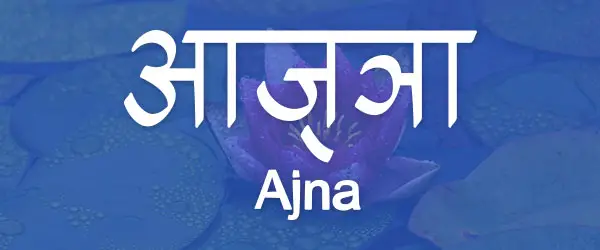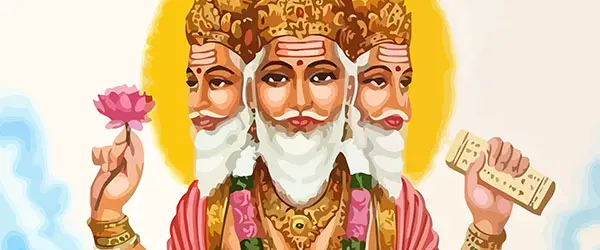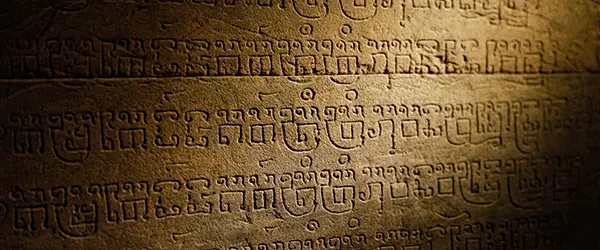The sixth chakra is commonly referred to as the third eye, but it also has another lesser known name. There is also the Sanksrit name for this energy center, and this article is going to explore the origins of this word.
The name of the third eye chakra is Anja, which is a Sanskrit word that means “perceive” or “beyond wisdom”. It can be traced back to the 2nd millennium BC, when Sanskrit was the language spoken in ancient India. The name Ajna was orally passed down by the Indo-Aryan people, before being written about in the Vedas, or holy texts of Hinduism.
To discover the true origins of the name of the third eye chakra, we must go way back in time to ancient India, and take a look at Hinduism, as well as the influence of the Aryan people, who invaded India nearly four thousand years ago.

Ajna in Sanskrit: आज्ञा
Why the Third Eye Chakra is Named Ajna
Ajna is the chakra of intuition, clairvoyance, and creativity. In Eastern philosophies it enables us to see beyond the veil of illusion, or “Maya”. Through the practice of yoga, meditation and other spiritual practices such as pranayama, trataka chakra shuddhi and neti, Ajna can be awakened, allowing for this perception.
Ajna is located between the eyebrows, in the middle of the head. It is associated with the pineal gland which regulates biorhythms, including sleep. The pineal gland produces melatonin, which regulates the circadian rhythm, or internal clock that the tells the body when to sleep and wake up. In reference to the location of Ajna between the eyebrows at the bridge of the nose, Hindus apply a vermillion bindi to show reverence.
In Eastern philosophy each chakra has a color, and the color of Ajna is indigo. Ajna also has a symbol, consisting of an om symbol within a lotus, which you can read more about here. Each chakra also has an element, with the lower chakras being associated with earth, water, fire, and air. Ajna is the sixth chakra, and one of the three that transcend matter. The element of Ajna is light.
Because the Ajna chakra deals with the spiritual matters of intuition and seeing beyond the veil of illusion, the ancient people of India gave this energy center the Sanskrit name Ajna, which translates to “perceive” or “beyond wisdom”. The word Ajna contains ‘a’ and ‘jna’ which means center without knowledge (‘a’ is without, and ‘jna’ is knowledge.) Through the practice of yoga and meditation, this ignorance can be overcome, and by awakening Ajna, supreme spiritual knowledge can be obtained.
Sanskrit Was the Language of Ancient India and Many Eastern Holy Books
The Sanskrit language is part of an Indo-European family of languages that includes Vedic Sanskrit (c. 1500 – 500 BCE). Mycenaean Greek (c. 1450 BCE) and Ancient Greek (c. 750 – 400 BC). In Hinduism, Sanskrit was used to communicate with the Hindu Celestial Gods. It is also widely used by Buddhism, Jainism, and Sikhism. The word comes from joining “Sam” meaning “entirety” with “krit” which means “done”.
Origins of the Sanskrit Language
Sanskrit is one of the oldest documented members of the Indo European family of languages, with a history going back 3500 years. The first earliest known composition in Sanskrit is the Rigveda, and ancient collection of Vedic Sanskrit hymns. It is one of the four sacred texts of Hinduism known as the Vedas.
It is believed that the Sanskrit language was created by the god Brahma, who passed it to the Rishis or Sages of ancient India. Rishi is a Vedic term to describe a person who has obtained enlightenment, or realized the supreme truth. The ancient Rishis of India were practitioners of yoga and meditation who composed their realizations into hymns.

Brahma the Hindu God of Creation
In Hinduism Brahma is the god of creation, and one of the three fundamental forces that constitute the Hindu trinity or “Trumurti”. Brahma — the creator, Vishnu — the sustainer, and Shiva — the destroyer. These three principles correspond to our existence as birth, life, and death.
Brahma is often depicted with four heads, four arms, and red skin. He sits in a lotus position and has a white swan as a vehicle. According to Hinduism, Brahma sprang from the cosmic golden egg and then created good & evil and light & dark.
The Hindu trinity was outlined in the Vedas by the Rishis, the enlightened sages of the Indo-Aryan people who lived in ancient India.
Indo-Aryan People of Ancient India
The Indo-Aryan people migrated from present-day Iran into India in 1800-1500 BCE, and settled in the Indus Valley and Ganges Plain. They were called the Aryans or “noble people” in the Sanskrit language by the local people, and brought with them religious customs. This blended with local Indus Valley cultures and became the Vedic Civilization. This civilization covered much of India, as well as parts of Pakistan and most of Bangladesh. It was from this civilization that the Vedas, the holy books of Hinduism were created.
The Vedas: Holy Texts of Hinduism
The oral traditions of the Aryans had been passed down for generations before becoming written in the Vedas, the holy books of Hinduism which are a collection of hymns and mantras. The chakra system is first mentioned in the Upanishads, one of the volumes of the Vedas. The Upanishads deals with meditation, philosophy, rituals and ceremonies, including references and descriptions of the chakra energy system.
Finding the Origins of the Chakra System in The Upanishads
The Upanishads were composed orally in Sanskrit between 700 BCE and 300 BCE. There are thirteen major Upanishads, which were likely composed by a variety of authors. The Upanishads are one of the earliest discussions on philosophical matters such as karma, yoga, saṃsāra (worldly existence), mokṣa (enlightenment), puruṣa (person), and prakṛti (nature), and are considered to be a forerunner to the subsequent philosophical traditions of India.
The Upanishads primarily deal with two main spiritual forces, Brahman (ultimate reality), and Atman (soul self).
Brahman means ‘universal soul’ or ‘world soul’ and is the essence of the universe and its ultimate divine reality. Brahman is the life force of all that is and will be throughout the cosmos.
Atman is the individual soul, or the essence of each individual. Each living thing – people, animals, plants have an atman that form our eternal essence. Atman is not the body, which is not eternal and simply houses the atman until it dies. The atman is eternal and immortal.
The Upanishads also contain volumes exploring yoga. 20 of the 108 volumes of the Upanishads deal directly with yoga, and include techniques on becoming aware of and controlling Prana, also known as life force energy. The chakra system is inextricably linked to yoga, which the ancient Rishis practiced to obtain spiritual knowledge. Included in the Upanishads are yoga poses, known as asanas, that directly work with the chakra energy system. This includes specific asanas related to the Ajna chakra, as well as methods of activating kundalini energy, and other concepts pertaining to tantra (sacred sexual practices), and meditation. You can read more about the role of kundalini energy and the third eye here.
Chakra in The Vedas
The word chakra appears in the Vedas as cakra, and means ‘wheel’ or ‘disk’. The word cakra appears 29 times in the Vedas, although many of the rich metaphorical symbolism contained within the Vedas is interpreted as dealing with the chakra energy system, including numerous references to the number 7, as well as serpents. For instance:
“The Seven Gods have seven spears and seven lights. They hold seven glories.” (Rg Veda 8.28.5) Translated by David Frawley in his book Gods, Sages and Kings.
A serpent is mentioned, which scholars interpret as a reference to Kundalini energy, which lays dormant at the base of the spine and rises up through the chakras during the chakra awakening process.
Allied with you in your friendship, celestial immortality, the [inner] controller of the senses made the waters flow for mortals. Killed the [dormant] serpent and sent forth the Seven Oceans, and opened as it were obstructed fountains.‘ (Rig Veda.IV.28.1)
Other Names For the Ajna Chakra
The Ajna chakra is also referred to by other names throughout history, including:
Third Eye Chakra
In modern times it is commonly referred to as the third eye chakra, because of its location and in that it deals with perception and seeing beyond Maya the veil of illusion.
The Guru Chakra
Because of it’s role in bringing down spiritual truths to the individual, the 6th chakra is sometimes called the guru chakra. “Gu” means darkness and “ru” means light, and dispels the darkness of ignorance. Guru is not actually a person, although it may operate through one, but rather guru is the higher knowledge itself.
Jnana Chakra
Related to the meaning of Ajna, which translates to “without knowledge”, Jnana means “with knowledge”. The knowledge of Ajna is lower knowledge, while the knowledge of Jnana is higher knowledge.
Brow chakra
Ajna is sometimes referred to as the brow chakra because of its location between the eyebrows just above the bridge of the nose.
Bhrumadhya Drishti
In yoga practice and meditation, this term is used to describe the process of focusing one’s attention on the third eye center. In Sanskrit, bhru means “eyebrow,” madhya means “center” and drishti translates as “seeing,” “gaze” or “eye.”
Recommended Reading
If you’d like to continue researching the third eye as well as the other chakras and energy systems, you can see which books I recommend on the subject by clicking here.


